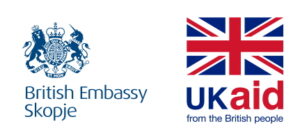Teofil Blazevski
 The fight against fake news and misinformation is much harder than all internationally undertaken and locally implemented or created measures and activities. It is a complex process in which neither media, institutionsor civil society organizations, let alone individuals, can fight on their own, and the consequences can be much more terrible than they are now.
The fight against fake news and misinformation is much harder than all internationally undertaken and locally implemented or created measures and activities. It is a complex process in which neither media, institutionsor civil society organizations, let alone individuals, can fight on their own, and the consequences can be much more terrible than they are now.
Two Albanian journalists were detained by the police and taken for questioning in connection with the news broadcast aired on their media on 23 September 2019, saying that an earthquake with a magnitude of over 6 is expected around midnight and will hit the region of Tirana. Journalists from various media (Syri.net and Gazeta Sheculli) published a news item in which they called on the people to leave their homes – and this actually happened, primarily due to the fear of damage caused by the earthquake the day before in the vicinity of Durres.
The panic over the fake news was reason enough to detain the journalists, although both media outlets quickly withdrew the news. However, one more thing was confirmed – the enormous power of the fake news to do harm.
This danger is especially evident in times of great national or global crisis, in times of great stress when people feel vulnerable, so they are reduced to a state of self-defense and are reaching for a narrative or misinformation that will allow them to feel, at least for a moment, more secure.
The global alarm immediately went off!
In global terms, the key actors in international politics and the international public health organizations, such as the World Health Organization (WHO), have immediately recognized the danger of misinformation or fake news, in parallel with the danger posed by viruses, such as the new coronavirus and its mutations.
The UN Secretary General Antonio Guterres, in the early stages of pandemic, on 28 May 2020 called this information threat ‘infodemic’. Before him, the President of the WHO, Tedros Gebresius, said the same. UNODC issued a warning on 31 March that the UN is taking steps to fight various crimes related to the virus ("sale of fake antiviral drugs through online orders, including cyber attacks on hospitals or important information systems"), but also "against spreading of false information about the virus".
At the same time, it was announced that a "Covid-19 Response" website has been created at the end of March 2020. WHO also has launched the Mythbuster website called "Tips for the public about Covid-19: Destroying the Myths".
This was followed by a series of international public campaigns. One of them is the Pause campaign of the UN, which advises the people to think about several things before sharing information ("the source of the information", "when it was published", "who sent me that information", "why should I share it"...). It was exactly this campaign, as it was recently announced by the UN and confirmed by a study carried out by the famous MIT (Massachusetts Institute of Technology) in the United States and the United Kingdom, which helped slow down the spread of misinformation and fake news.
Fact checking is important for both the traditional media and the social media
Some of the information on countermeasures on a global and local level were the strengthening of the fact checking mechanisms, which took place on two levels. The first level was taken autonomously by the existing verified members of the International Network of Fact Finders (IFCN - part of the Pointer Institute), who, as part of their regular work, began to check the facts on the various information in the media about the virus and the disease.
The second level was taking responsible actions by the companies that today own the most powerful social media, such as Facebook. They decided to independently counteract the misinformation in two ways - to identify them automatically or to control them manually and to remove or flag (label) the posts. They found that, for the purpose of credibility of the process, it is better to use the fact-checking services created by Facebook according to certain rules, and to use all methods of fact checking and to flag the false or partially false claims in the posts. Facebook then shades them and leaves links with information as to why it was done. The most recent measure taken by Facebook is a full profile warning that it continuously spreads fake news or misinformation. "Vistinomer" is also a member of this network of international "fact-checkers" that has a cooperation agreement with Facebook (since last August), as the only medium verified by IFCN that does fact checking in Macedonia.
Fake news kills!
The pandemic of 2020 and 2021 and the spread of the corona virus, is the most recent example of this old phenomenon, which now emerges in a new form, which can be also analyzed in Macedonia, because the effects on the Macedonian society are visible. It is important to note that fake news can kill! This has been proven not only by the pandemic, but throughout the centuries old history of misinformation, which in our country, for example, could be seen during another crisis – the one that happened in 2001. The book that can be considered as one of the relevant sources on this matter is Testimonies 2001 by the late General Pande Petrovski, at that time Chief of Staff of the Macedonian Army (see p.88, p.91, p.194 ...).
That is why the fight against misinformation is so important – because it is not just a media issue or how one media system is established, but it is a much more important and bigger issue, which is primarily political, and which, simply put, comes down to a fight between the pro-democratic and anti-democratic forces.
In fact, the problem of misinformation and fake news is a new kind of war. Seventy five percent of the citizens of the Western Balkans agree to it. According to the same research (RSS Securometer), as much as 82 percent of the citizens of Macedonia also agree with it.
 Source: makfax.com.mk
Source: makfax.com.mk
The trends in Macedonia are similar or the same as the global ones
The Metamorphosis Foundation from Skopje, which is also the publisher of the "Vistinomer" media project, recently announced an analysis of misinformation related to Covid-19 in the country. The introduction of this Analysis states the following:
"The analysis of misinformation related to the Covid-19 pandemic shows that their strength depends on the existing social factors, which are conducive to the spread of various forms of manipulation (social cohesion, levels of education, trust in institutions, degree of respect for human rights, including freedom of expression) and that in the Republic of North Macedonia there was already a fertile ground for the spread of infodemic through the existing propaganda structures (related to abuse in the local political context) and through social media carried out by individuals and groups unrelated to the established centers of power. Most of the misinformation was not original, but was imported from the global media sphere or was misinformation spreading across the borders in the Balkan region."
The conclusions and observations of the Analysis were based on approximately 500 published misinformation that were detected by "Vistinomer", "CriThink" and the regular work of the media META and Portalb media, which are also published by "Metamorphosis".
In terms of percentages of misinformation related to conspiracy theories, the leading narrative is that the "Pandemic is an artificial virus released into the country" with 9% of the sample, followed by claims that it is a work of "a new world order, the Masons, the anti-globalists" with 6 percent, a high 5 percent refer to the narrative that "the disease does not exist" or that “it is Bill Gates' involvement”, 4 percent refer to the explanation that "the pandemic is because of the development of the 5G network", etc.
Three sources and carriers of misinformation
The practice confirms that the origin of misinformation is domestic or foreign/ global. Very important in analyzing the sources and platforms of misinformation is to detect the influence of three actors: a) political parties; b) the capacity of the media themselves (which, with this model of business operation, are often vulnerable and intentional or unintentional disseminators of misinformation due to lack of capacity to hire journalists with professional standards; followed by the excessive use of "copy-paste" journalism and reaching for sensationalism as а way of affirmation ("click-bait" journalism...); c) social media profiles (where misinformation is spread because of ignorance and non-verification, or deliberate spreading of misinformation and fake news with strictly targeted goals and effects).
During the pandemic 2020/2021 all three sources of misinformation or fake news were and are in play in Macedonia, so, when it comes to impressions from practice, we can say that the traditional or media operating in a regulated market (broadcast media) were and are a small source or carrier of misinformation because of rushing in and ignorance, but not when they were platforms for misinformation originating from the political parties. This can be mostly noticed through the spinning reporting in favor of only one political party, most often the largest opposition party, but also when they spin about the success of the government in the fight against the pandemic.
At the second place we have the online media, where there is a difference between the more professional (with newsrooms and impressum) and those "illegal" – ‘one-man-show’ portals.
In the online media, as it was already pointed out, the main problem are the capacities and the sensationalism, and this is confirmed by the statistics of analyzed complaints received by the Council of Media Ethics in Macedonia (CMEM), for the period March 2020 - February 2021.
Finally, in social media, which have become the main source and transmitter of misinformation, the main problem is the power derived from their size and global connection and the balanced approach towards respecting the freedom of speech, with the active measures taken by the companies themselves in flagging or removing the posts. The controversy that has arisen over this is well known, especially when Donald Trump was banned from using the official and personal profile after the end of his term. It is also known what hate speech the Metamorphosis employees face, for example, during a campaign that is already in its 8th month and in which threats of violence, including calls for lynching or murder, are not uncommon. On top of that, even with such measures to combat misinformation on the social media, the effects do not seem to be too great, although they are visible in terms of reducing the sharing.
Active and semi-active transparency?
The question of how to deal with misinformation, as we see in the first part of this text, is global, not just local. Although the Macedonian Government immodestly wants to boast that it had a Plan for Fight Against Misinformation since long time ago, as well as a Crisis Management Protocol, whose basic and most important factor is the so-called active transparency, in practice this is not always how things work, although, undoubtedly, some of the activities were useful and helped to reduce the spread of misinformation and fake news.
But what if the transparency is just semi-active, or when the government itself, as holder of information, is the cause of some of the misinformation? What to do when there is no wish to interpret some of the measures in the right way or when there is inconsistent treatment of the violators of those measures. As examples, I would just like to mention the stricter measures that were not clearly explained or were introduced late, related to full lockdown, in particular during 2020 and more particularly during the important religious holidays of the two largest religions in the country, or the inconsistent implementation of the measures, control of the compliance with the curfew, extensive or minor punishment, weak inspection services in terms of personnel (for which, however, we must say were zealous - at least the Market Inspectorate), etc.
One of the most evident examples when the Government itself is (intentionally or unintentionally) causing misinformation, happened at the end of 2020 and earlier this year, when both the Prime Minister and the Minister of Health were announcing, on daily basis, the arrival of quantities of vaccines that in reality weren’t arriiving, or arrived in numbers far below the announced quantities.
Summing up all the experience and lessons learned, it is important to note that the fight against fake news and misinformation is much harder than all internationally undertaken and locally implemented or created measures and activities. It is a complex process in which neither the media, institutions nor civil society organizations, let alone individuals, can fight on their own. More importantly, the process is long and takes many years, in which one of the key factors is both general and media literacy. But most importantly, if we do not start immediately on the basis of a strategic plan, in which there will be good measures and which needs to be implemented consistently, the damage can be much greater than what we are witnessing today. These are consequences of cataclysmic proportions, as after every great war when the forces of light oppose the forces of darkness in the arena!
The blog was created as part of the “Tales from the Region” initiative led by the Macedonian Res Publica and Institute of Communication Studies, in cooperation with partners from Montenegro (PCNEN), Croatia (Lupiga), Kosovo (Sbunker), Serbia (Don’t Le Belgrade D(r)own), Bosnia and Herzegovina (Analiziraj.ba), Albania (Monitor.al) and Greece (Macropolis), within the project "Connecting the Dots: Improved Policies through Civic Engagement" with the support of the British Embassy in Skopje.
Please refer to the Terms before commenting and republishing the content.
Note: The views and opinions expressed in this article are those of the author and do not necessarily reflect the views of the Institute of Communication Studies or the donor.


